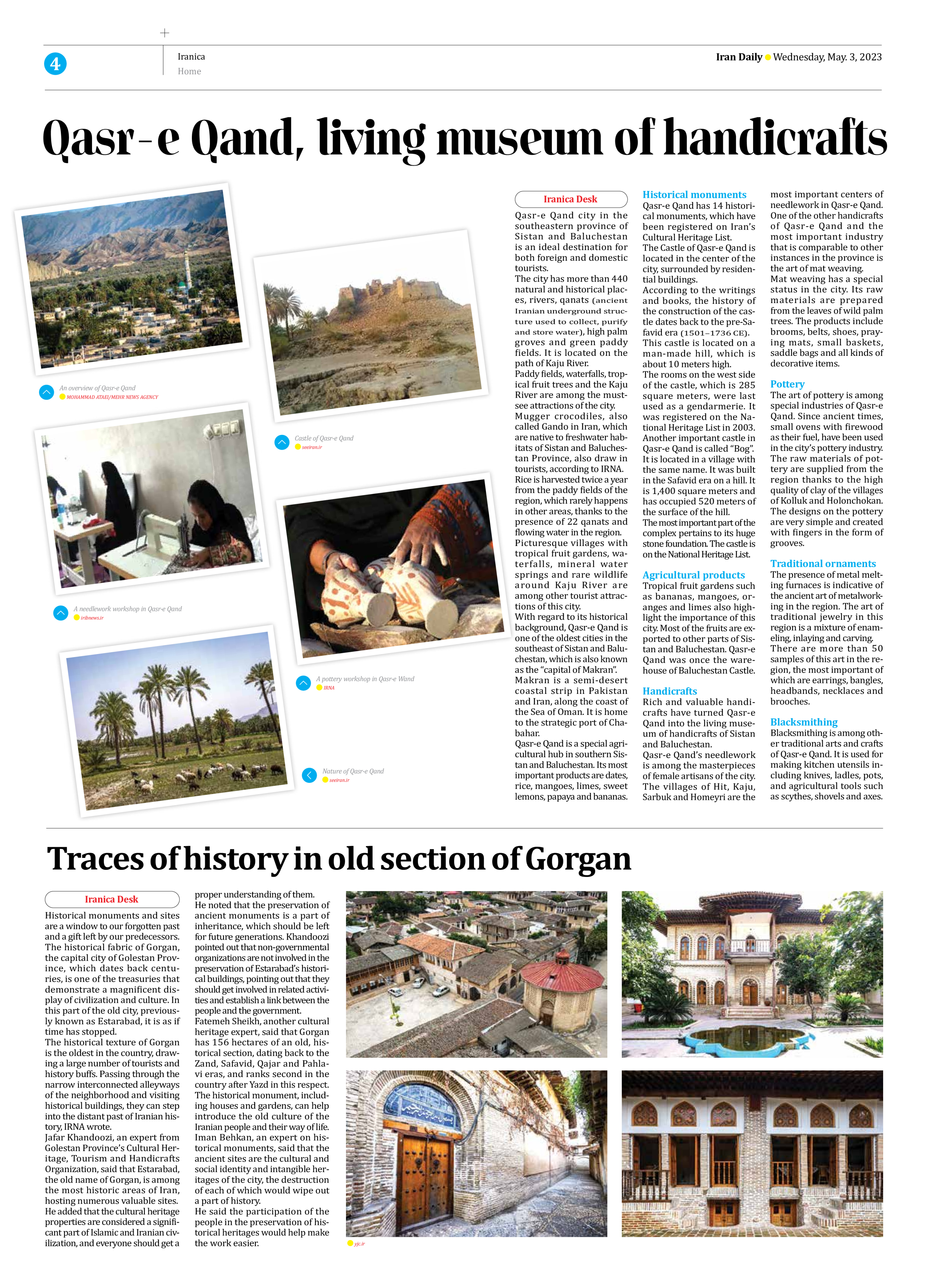
Qasr-e Qand, living museum of handicrafts
Qasr-e Qand city in the southeastern province of Sistan and Baluchestan is an ideal destination for both foreign and domestic tourists.
The city has more than 440 natural and historical places, rivers, qanats (ancient Iranian underground structure used to collect, purify and store water), high palm groves and green paddy fields. It is located on the path of Kaju River.
Paddy fields, waterfalls, tropical fruit trees and the Kaju River are among the must-see attractions of the city.
Mugger crocodiles, also called Gando in Iran, which are native to freshwater habitats of Sistan and Baluchestan Province, also draw in tourists, according to IRNA.
Rice is harvested twice a year from the paddy fields of the region, which rarely happens in other areas, thanks to the presence of 22 qanats and flowing water in the region.
Picturesque villages with tropical fruit gardens, waterfalls, mineral water springs and rare wildlife around Kaju River are among other tourist attractions of this city.
With regard to its historical background, Qasr-e Qand is one of the oldest cities in the southeast of Sistan and Baluchestan, which is also known as the “capital of Makran”.
Makran is a semi-desert coastal strip in Pakistan and Iran, along the coast of the Sea of Oman. It is home to the strategic port of Chabahar.
Qasr-e Qand is a special agricultural hub in southern Sistan and Baluchestan. Its most important products are dates, rice, mangoes, limes, sweet lemons, papaya and bananas.
Historical monuments
Qasr-e Qand has 14 historical monuments, which have been registered on Iran’s Cultural Heritage List.
The Castle of Qasr-e Qand is located in the center of the city, surrounded by residential buildings.
According to the writings and books, the history of the construction of the castle dates back to the pre-Safavid era (1501–1736 CE).
This castle is located on a man-made hill, which is about 10 meters high.
The rooms on the west side of the castle, which is 285 square meters, were last used as a gendarmerie. It was registered on the National Heritage List in 2003.
Another important castle in Qasr-e Qand is called “Bog”.
It is located in a village with the same name. It was built in the Safavid era on a hill. It is 1,400 square meters and has occupied 520 meters of the surface of the hill.
The most important part of the complex pertains to its huge stone foundation. The castle is on the National Heritage List.
Agricultural products
Tropical fruit gardens such as bananas, mangoes, oranges and limes also highlight the importance of this city. Most of the fruits are exported to other parts of Sistan and Baluchestan. Qasr-e Qand was once the warehouse of Baluchestan Castle.
Handicrafts
Rich and valuable handicrafts have turned Qasr-e Qand into the living museum of handicrafts of Sistan and Baluchestan.
Qasr-e Qand’s needlework is among the masterpieces of female artisans of the city.
The villages of Hit, Kaju, Sarbuk and Homeyri are the most important centers of needlework in Qasr-e Qand.
One of the other handicrafts of Qasr-e Qand and the most important industry that is comparable to other instances in the province is the art of mat weaving.
Mat weaving has a special status in the city. Its raw materials are prepared from the leaves of wild palm trees. The products include brooms, belts, shoes, praying mats, small baskets, saddle bags and all kinds of decorative items.
Pottery
The art of pottery is among special industries of Qasr-e Qand. Since ancient times, small ovens with firewood as their fuel, have been used in the city’s pottery industry.
The raw materials of pottery are supplied from the region thanks to the high quality of clay of the villages of Kolluk and Holonchokan. The designs on the pottery are very simple and created with fingers in the form of grooves.
Traditional ornaments
The presence of metal melting furnaces is indicative of the ancient art of metalworking in the region. The art of traditional jewelry in this region is a mixture of enameling, inlaying and carving.
There are more than 50 samples of this art in the region, the most important of which are earrings, bangles, headbands, necklaces and brooches.
Blacksmithing
Blacksmithing is among other traditional arts and crafts of Qasr-e Qand. It is used for making kitchen utensils including knives, ladles, pots, and agricultural tools such as scythes, shovels and axes.







